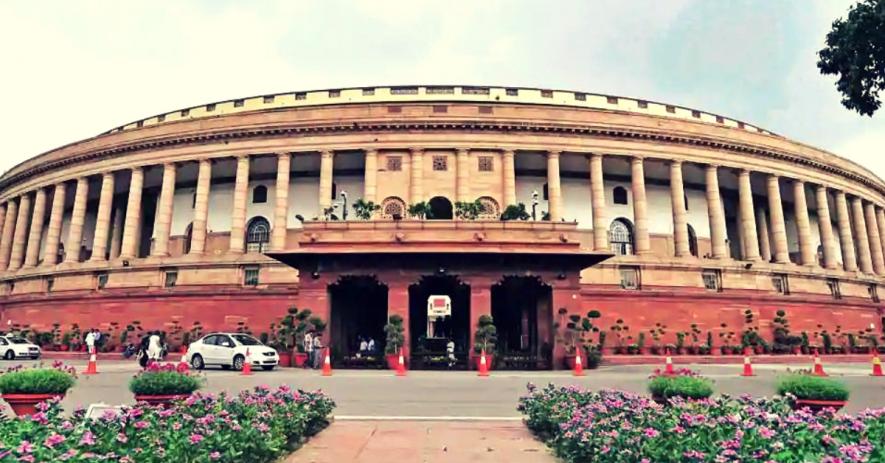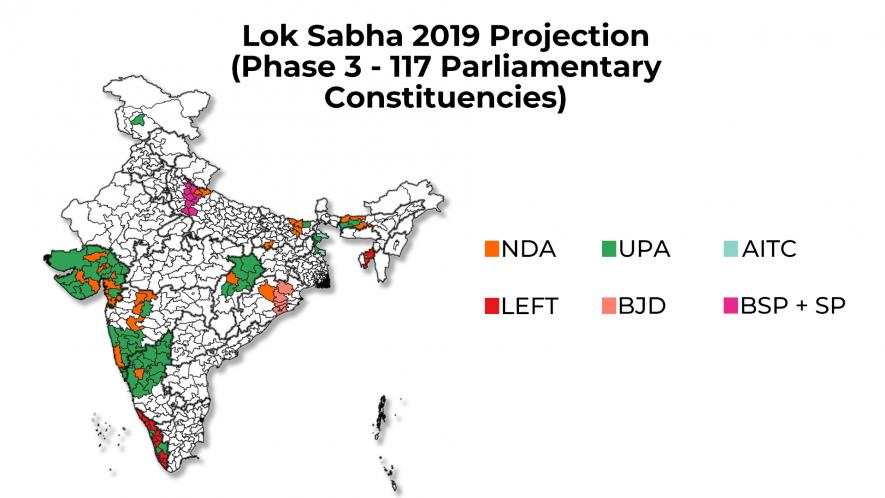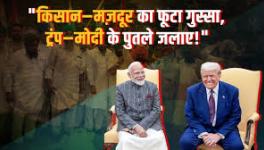Elections 2019: NDA Slide Continues in 3rd Phase of Polls

Adding to the losses projected for the Bharatiya Janata Party-led National Democratic Alliance (NDA) in the first two phases of polling, the downward slide of the ruling front appears to be continuing in phase 3 polling held on April 23. Across 14 states, 117 seats went to polls in this phase which was marred by sporadic violence in West Bengal and UP, and low turnout in strife-torn J&K’s Anantnag seat (polling in part), but was otherwise peaceful. Tripura East too went to polls in this phase after postponement from the second phase.
The projected outcome of this round of seven-phase polling is that out of 117 seats, the NDA tally will dip from 67 in 2014 to just 29. The Congress-led United Progressive Alliance (UPA) would make substantial gains, increasing its seats from 26 in 2014 to 57. The other significant gainers would be the Left Democratic Front in Kerala and the BSP-SP-RLD Gathbandhan in Uttar Pradesh.



These projections have been done on the basis of most recent Assembly election results for each state, application of suitable swing away from ruling party taking into consideration diverse state-level political factors and based on new alliances in states – like the Bahujan Samaj Party-Samajwadi Party-Rashtriya Lok Dal Gathbandhan in UP, formed after the last Assembly elections in 2017.
Also Read | Elections 2019: Vijender Singh, Gautam Gambhir in the Fray in Delhi; Here’s Why Both Deserve To Lose
In Bihar, the 2014 general elections were used for basing the projections because subsequent Assembly elections in 2015 saw the Lalu Prasad Yadav-led Rashtriya Janata Dal (RJD) ally with Nitish Kumar-led Janata Dal (United) (JD-U) but then Nitish Kumar walked out of the alliance and joined up with his former ally, the BJP, again. Since the 2015 Assembly election results in Bihar represented the combined votes of the two parties that are now on opposing sides, it is impossible to segregate the two parties’ votes. Hence, the 2014 Lok Sabha results are the only option where everybody was fighting separately.
Swings applied to various state results are: Assam (5%); Bihar (8%); Chhattisgarh (3%); Goa (2%); Gujarat (2.5%); Jammu & Kashmir (2%); Karnataka (2%); Kerala (0%); Maharashtra (5%); Odisha (5%); UP (3%); West Bengal (5%); Dadra & Nagar Haveli (3%); Daman & Diu (3%); and Tripura (5%).
Among the states where BJP is projected to lose heavily are Gujarat, Karnataka, Maharashtra, Chhattisgarh and UP.
An over-arching factor being considered is the performance of the Modi government on various counts including employment, farmers’ incomes, wages of workers, corruption, GST, demonetisation, communal strife and minorities’ sense of security, and the ‘national security’ motif. In the balance, the interplay of these considerations in voters’ minds is also mediated through their respective experiences of the state governments. A balance of these is aimed at in the different swings applied. Ground reports appear to indicate that unemployment and farmers’ debts/incomes are very big issues weighing on voters’ minds and on these counts, there is a high degree of alienation from the Modi government.
If this is the case, then it is not surprising that these projections appear to indicate that the Modi-led NDA is likely to lose the elections because the most important issues like economic distress are pan-Indian and the trend of the first three phases will be replicated elsewhere in different degrees.
[Data analysis by Peeyush Sharma and mapping by Glenissa Pereira]
Get the latest reports & analysis with people's perspective on Protests, movements & deep analytical videos, discussions of the current affairs in your Telegram app. Subscribe to NewsClick's Telegram channel & get Real-Time updates on stories, as they get published on our website.
























